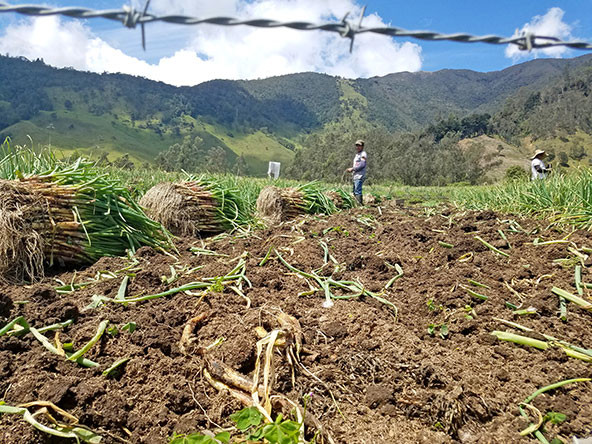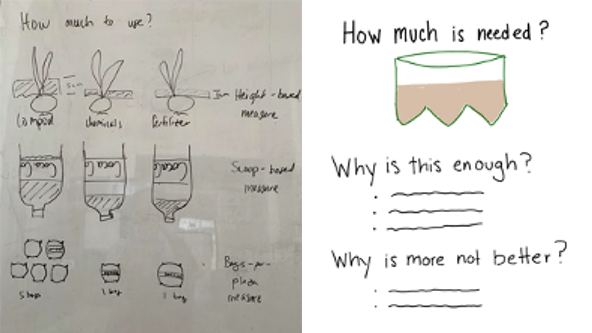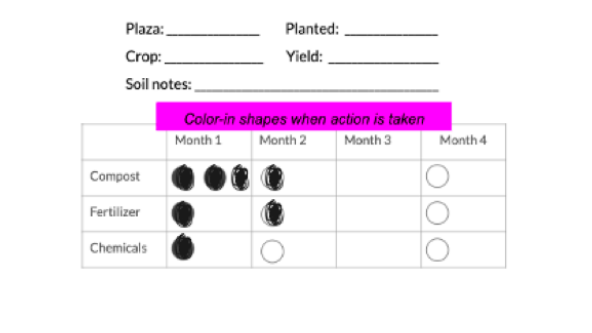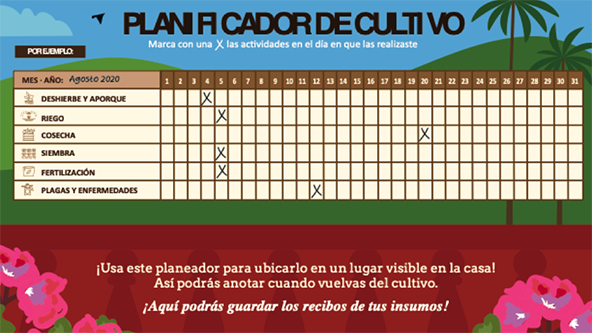 An onion field in El Moral, Valle del Cauca. This department in southwestern Colombia witnessed significant upheaval during the 40-year internal conflict.
(Photo courtesy of Rare)
An onion field in El Moral, Valle del Cauca. This department in southwestern Colombia witnessed significant upheaval during the 40-year internal conflict.
(Photo courtesy of Rare)
We are living in a climate-variable world, in which seasons are less stable and natural disasters are rising in frequency. No one experiences this instability more acutely than the smallholder cultivators who produce 70 percent of the world’s food. Take Colombian onion farmer Doña Gilma: She has been working the land for 32 years, but her formula of chemical fertilizers, pesticides and raw chicken manure is now failing. She can connect her smaller harvests and rotting onion roots to the longer, hotter summers and unseasonal rainfall. But she has more questions than answers. How much fertilizer is too much fertilizer? Is more irrigation always better? Would composting really boost yields?
As the natural world’s fluctuations become the norm, agricultural decision makers can no longer rely on generationally passed-down knowledge. In this sense, climate change is also an “ambiguity problem” experienced by frontline communities as an impasse: what you know no longer works. The speed and scale at which these transformations are taking place demand dynamic responses at the individual level, or what’s sometimes called “autonomous adaptation.” After all, climate expertise is still largely concentrated in the hands of scientists and policymakers thousands of miles away from the sites at which adaptive practices are most required. But “ambiguity problems” demand locally owned solutions, fixes that make sense to farmers and fishers confronting subsistence challenges in real time.
Enter design thinking, an approach to building solutions with, and for communities closest to the challenge in hand.
Designing Solutions
A recent project between Rare and Stanford University’s d.school used design principles to tackle the high-stakes ambiguity problem faced by Colombian onion farmers: how much chemical input is enough for onions to prosper without degrading already overtreated soil? This is but one instance of an ambiguity problem in one corner of the world. However, the issue remains of how we address ambiguity problems, which threaten timely climate adaption in the planet’s most vulnerable places. Our hope is for more and more changemakers to consider a design thinking lens in situations where “what you know no longer works.”
Are you enjoying this article? Read more like this, plus SSIR's full archive of content, when you subscribe.
José Valencia is a smallholder tenant farmer in Colombia’s Valle del Cauca region. He has noticed his soil’s diminishing productivity but would be hard pressed to explain why. Keeping records of input quantities and costs is not common practice, especially for first-generation farmers like Valencia who have recently migrated to Valle from neighboring Nariño department, a result of the large-scale displacement following Colombia’s 40-year internal conflict. Instead, Valencia’s working assumption is that more inputs better his odds of a big harvest of large-sized onions, the kind most sought after because they create perfect rings for topping burgers, Colombia’s favorite food.
Expert consensus on the danger posed by chemical inputs to soil regeneration is well established. But while government agricultural extension agents suggest calibrating inputs according to soil needs, the last mile delivery of this recommendation to frontline communities remains a fraught process without clear scripts. In the face of climate change, the ambiguous, evolving nature of the problem only makes farmers less likely to change their traditional practices, especially when they lack accessible information or evidence from peers successfully adopting new adaptive solutions.
Instead of asking how communities can be taught the “right” science to cultivate in climate-friendly ways, the Rare-d.school collaboration prioritized a different question: which lived experiences allow communities to better understand and assess their own environments? How can communities be empowered with the right data-driven tools to manage their resources? The critical shift is to acknowledge the intrinsic ambiguities underlying our natural world. A knowledge-driven agility must inform how scientists, designers, changemakers, and frontline communities respond to future environmental challenges.
The Rare-d.school team undertook a research process centered on farmers’ experiences with, and understanding of, soil health. How does a smallholder cosechero (harvester) grapple with the twin challenge of securing livelihood and ensuring soil renewal for successive harvests? Despite the constraints imposed by the ongoing global lockdown to slow the spread of COVID-19, team members devised remote research strategies to replace the traditional face to face interview, gathering perspectives from individuals near Valle del Cauca, and comparative research on smallholder cultivators facing similar choices between soil productivity and soil regeneration in the American Midwest.
A picture began to emerge: Cauca’s cosecheros were precarious, living one harvest to the next. They did not own the land they cultivated, making any investment into soil contingent upon whether it would improve their livelihood first, with environmental co-benefits coming second. Fertilizers were expensive, and most were attempting to treat worsening soil quality with raw chicken manure. Rare’s Land for Life program has been working with local partners to revive the importance of soil for sustained livelihoods among farmers. Without being able to immediately see the benefits of modified inputs or composting, farmers were reluctant to bear the financial risk of adopting new cultivation methods.
The team’s approach was therefore to take as much ambiguity as possible out of farming and do so in the language farmers understand.
 Preliminary design stages of the record keeping tool show students tackling the farmers’ core dilemma, “How much fertilizer to use?”
Preliminary design stages of the record keeping tool show students tackling the farmers’ core dilemma, “How much fertilizer to use?”
For example, farmers speak in the language of “good” or “bad” years. But the joint effort led to a realization that a tactile, visual guide could help farmers better understand their soil, alongside an easy to use tracker to account for how monthly fertilizer use correlates with success.
 Solution Prototype: Ankur Das, Kana Hammond and Matilda Nickell, Stanford University d.school ‘Design for Extreme Affordability’ Spring 2020.
Solution Prototype: Ankur Das, Kana Hammond and Matilda Nickell, Stanford University d.school ‘Design for Extreme Affordability’ Spring 2020.
At the d.school, students create multiple directions for a solution and get feedback throughout a project’s duration from partners and end-users, increasing the odds that their solutions are relevant and useful. These rough sketches point to the need to incorporate indigenous modes of measurement that are already in daily use. Team member Matilda Nickell, a senior at Stanford majoring in psychology, said, “We were encountering widely different numbers during our research and the amount of fertilizer recommended by extensionists varied significantly from the amount farmers were actually using. That’s when we thought, why not use the units of measurement that were already popular with cosecheros?” The iterations illustrated above turned into a monthly “visual checklist” that allows farmers to track their inputs in terms of “fistful,” “jugs” or “bags”:
 The Planificador de Cultivo (‘Crop Planner’) page from the ledger book customized for farmers, Anota los Costos de Producción de tu Cultivo (‘Production Costs of your Crop’).
The Planificador de Cultivo (‘Crop Planner’) page from the ledger book customized for farmers, Anota los Costos de Producción de tu Cultivo (‘Production Costs of your Crop’).
 The Tarjeta Suelo Sano, or ‘Soil Health Card’, co-developed by Rare and in-country partner, Asomaime. (Photos courtesy of Rare)
The Tarjeta Suelo Sano, or ‘Soil Health Card’, co-developed by Rare and in-country partner, Asomaime. (Photos courtesy of Rare)
The next steps involved working closely with a visual illustrator and Rare staff to create a field-ready toolkit for record keeping and soil analysis. Both tools’ final versions eschew the didactic register common in materials developed for end users. The Soil Health Card breaks down soil into its texture, smell and humidity, elements that are part and parcel of farmers’ daily work on the land. A simplified ledger asks farmers to cross out weeks alongside rows detailing particular activities like weeding (deshierbe), sowing (siembra), fertilizing (fertilización) and spraying pesticides (plagas y enfermedades). The tools will need to be tested and iterated over several growing seasons, continuously refined and ensured they are meeting both farmers’ and soil health goals.
In the long term, success will require at least three dimensions. The broadest, most ambitious goal is to ensure that this land continues to sustain the humans and rest of the natural ecosystem that depends on it, in perpetuity. But at the most basic level, success will be achieved if these tools help farmers make ecologically and financially rewarding input decisions, and in doing so, gain agency as self-reliant producers solving the challenges of agriculture in our climate variable world, in real time. And yet another type of success will be achieved if these tools can draw practitioners’ lived expertise and scientific knowledge into the same conversation.
In conclusion, this is just one example of where decision-making by individuals who have one part of the picture can add up to meaningful impact for an entire region, the difference between whether the land is over-fertilized and exhausted or can be farmed successfully for generations to come. This challenge is amplified by the volatility caused by the changing climate. Instances of “what you know no longer works,” we suggest, demand new decision-making tools, designed for and with the people instrumental to long-term resource management. The qualities of design thinking i.e., understanding the problem from a human perspective, exploring and testing a range of different solutions, and iterating repeatedly, are a good match for the collaborative improvisation required to change how people relate to and manage the planet’s finite resources.
Support SSIR’s coverage of cross-sector solutions to global challenges.
Help us further the reach of innovative ideas. Donate today.
Read more stories by Sarah Stein Greenberg & Madhuri Karak.

